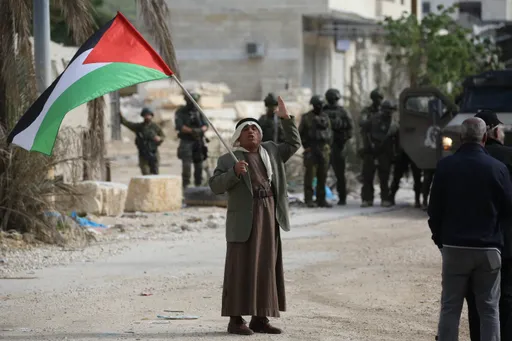A few days ago, Slovenian media uncovered the existence of a non-paper (unofficial diplomatic note) which dealt with the potential for the ‘dissolution’ of Bosnia and Herzegovina and drawing up new borders along ethnic lines in the Balkans.
People in Bosnia and Herzegovina learned a long time ago that once somebody, somewhere starts ‘drawing’ ‘new borders,’ this usually means that, in the best version of events, Bosniaks are going to end up in exile.
A quarter of a century ago, Serbian and Croatian leaders ‘drew’ up new borders similar to the ones their predecessors did in 1939, on the eve of World War II. Both times, the euphemism of ‘drawing’ has meant that Bosniaks end up in enclaves, refugee convoys and mass graves.
Slovenia, led by Janez Jansa, a far-right politician, with strong ties to other far-right politicians throughout Europe, most notably Hungarian President Victor Orban, also has strong ties in Republika Srpska, the Bosnian Serb entity within Bosnia and Herzegovina. As early as 2018, an investigation was launched into a hefty loan given to Jansa’s party by a businesswoman from Republika Srpska.
The timing of the non-paper is especially concerning since Slovenia will hold the Presidency of the Council of the European Union from July 1 to December 31, 2021 when attempts to push this agenda forward could be expected.
Over the years, Bosnian Serb and Bosnian Croat political leaders, with the help of allies within government institutions of Serbia and Croatia, have pushed for the idea for the dissolution of Bosnia and Herzegovina along ethnic lines so as to merge into a ‘Greater Serbia’ and ‘Greater Croatia’.
The Covid-19 pandemic, rising Russian and Chinese influence in the region, destabilisation attempts in Montenegro and North Macedonia and the rise of nationalism, populism and far-right extremism have brought the region into a tough position once again. A network of far-right actors, namely Hungarian Prime Minister Viktor Orban, have overtaken the public space and political discourse across the region, and increasingly beyond it.
In February 2018, Italian far-right leader Giorgia Meloni met with Viktor Orban. During their meeting, a demographic map of Bosnia and Herzegovina was present on the wall. There was no official explanation, but it seems obvious that a discussion occurred about the country’s demographics. Later that year, another photograph of Orban, in front of the same map, was published, with him holding a book published in 2017 by Douglas Murray titledThe Strange Death of Europe: Immigration, Identity, Islam. Its major argument is that immigration is destroying Europe.
Orban has also established ties with other nationalist and far-right politicians in the region: in 2019 he met with Milorad Dodik, the Bosnian Serb member of the BH Presidency. After the meeting, Orban stated that“The intensity of these relationships [with Republika Srpska] is not what it might be. We intend to strengthen relations between Budapest and Banja Luka [the administrative centre of Republika Srpska].” Dodik had previously met and discussed cooperation with delegations of far-right parties from Italy, Hungary and Austria.
Recently, Orban also started meeting with Serbian President Aleksandar Vucic on a regular basis. Former North Macedonian nationalist Prime Minister Nikola Gruevski fled to Hungary in 2018 to evade a prison sentence for an illicit purchase of a Mercedes. He was also suspected of being behind the 2017 mob storming of the Macedonian parliament.
The 2020 elections in Montenegro brought a pro-Serbian and pro-Russian coalition into power, polarising society and destabilising the country. This came after several years of malign foreign influence in the country which reached its peak in 2016 when several Russian spies were arrested over a failed coup attempt.
Since the elections, Bosnian genocide denial has been on the rise. Most recently, the Minister of Justice, Human and Minority Rights has refused to recognize the 1995 Srebrenica genocide until “it is unequivocally established”.
The wave of far-right ideologies and growing networks in Southeast and Eastern Europe is on the rise. The 2014 war in the Donbass region in Ukraine exposed how well connected these networks are with one another. Croats were fighting alongside Ukrainian forces while the Serbs supported pro-Russian separatists. Foreign fighters from the region continue to take part on both sides of the conflict, and as the conflict recently intensified, so have the number of volunteers from the region.
Links between paramilitary units and political elites in the region, kept secret until then, were uncovered last year. These links also reached the level of diplomatic scandal when the Bosnian Serb member of the Bosnia and Herzegovina Presidency, Milorad Dodik, gifted Russian Foreign Minister Sergey Lavrov an Orthodox Christian icon which turned out to be plundered during the ongoing war in Ukraine, during a recent state visit to Bosnia and Herzegovina. Once this scandal was uncovered, Lavrov immediately returned the gift to the Embassy of Bosnia and Herzegovina in Moscow.
For a long time, the threat of far-right ideologies and populism in the Balkans has been neglected. It has given it time to expand and grow. We have now come to a stage where these policies have become normalised and the region is under threat of destabilisation. Bosnia and Herzegovina seems to be first on the to-do list. If left unopposed, other vulnerable groups will be targeted next.
























